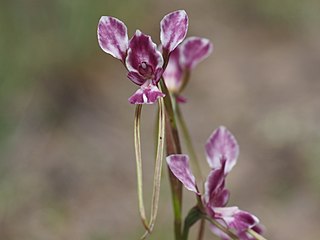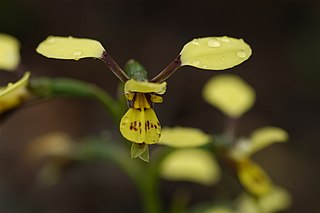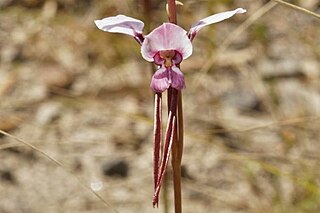Diuris maculata, commonly known as the spotted doubletail is a species of orchid which is endemic to New South Wales. It has up to two or three folded leaves and a flowering stem with up to eight yellow flowers with brown to blackish markings. It is similar to D. pardina which has darker flowers with larger brown markings.

Diuris sulphurea, commonly called the tiger orchid or hornet orchid, is a species of orchid which is endemic to eastern Australia. It has up to three leaves, and a flowering stem with up to seven bright yellow flowers with dark brown markings.

Diuris protena, commonly known as northern golden moths, is a species of orchid which is endemic to Victoria. It has a tuft of between four and eight leaves at the base and up to three mostly yellow flowers with a few light-coloured marks. It is classed as "endangered" in Victoria.

Diuris aequalis, commonly called the buttercup doubletail, is a species of orchid which is endemic to New South Wales. It has two rolled leaves and spikes of two to five golden-yellow to orange flowers and is classified as "vulnerable".

Diuris abbreviata, commonly known as the lemon doubletail, is a species of orchid that is endemic to eastern Australia. It has two or three leaves and a flowering stem with up to nine yellow flowers with darker markings.

Diuris dendrobioides, commonly known as the wedge diuris, is a species of orchid which is endemic to eastern Australia. It has one or two leaves and a flowering stem with up to six pale lilac-coloured to mauve flowers with darker markings.

Diuris praecox, commonly known as the early doubletail, Newcastle doubletail or rough doubletail is a species of orchid which is endemic to New South Wales. It has two or three grass-like leaves and up to ten light yellow flowers with a few dark brown marks. It is threatened by urbanisation.

Diuris arenaria, commonly known as the Tomaree donkey orchid or sand doubletail is a species of orchid which is endemic to a very small area of New South Wales. It has two grass-like leaves and up to nine mauve or light purple and white flowers. It has a very limited distribution near Newcastle.
Diuris chrysantha, commonly known as granite donkey orchid, is a species of orchid that is endemic to eastern Australia. It has one or two leaves and up to seven deep golden to orange-coloured flowers with brown markings and occurs on the ranges and tablelands north from Tamworth to the Darling Downs.

Diuris concinna, commonly called the elegant donkey orchid, is a species of orchid which is endemic to the south-west of Western Australia. It has up to five linear leaves at its base and up to five pale yellow flowers with brown markings. It is found along the south coast, often growing in areas that are flooded in winter and flowering more prolifically after fire the previous summer.
Diuris disposita, commonly called the Macleay River doubletail or Willawarrin doubletail, is a species of orchid which is endemic to a small area in New South Wales. It has one or two linear leaves at its base and up to seven yellow flowers with brown markings. Only about fifty plants survive in grassy forest near Kempsey.
Diuris eburnea is a species of orchid that is endemic to the south-west of Western Australia. It has between four and six linear leaves and up to eight pale yellow to cream-coloured flowers with reddish markings. It is only known from near the Arrowsmith River north of Eneabba.
Diuris exitela, commonly called the Mount Moffat doubletail, is a species of orchid which is endemic to central western Queensland. It has two linear leaves at its base, up to twelve bright yellow flowers with dark brown markings and grows on sandstone cliffs and ridges.
Diuris flavescens, commonly called the pale yellow doubletail or Wingham doubletail, is a species of orchid which is endemic to a small area in New South Wales. It has two linear leaves at its base and up to five pale yellow flowers with dark brown markings. Fewer than 200 plants survive in grassy forest near Wingham.
Diuris fragrantissima, commonly called the fragrant doubletail or Sunshine diuris, is a species of orchid which is endemic to a small area to the west of Melbourne. It has two linear leaves at its base and up to twelve white flowers with mauve or pale purple markings with unusually long lateral sepals. Only about thirty plants survive in grassland near Sunshine.
Diuris micrantha, commonly called the dwarf bee orchid or tiny bee orchid, is a rare species of orchid which is endemic to the south-west of Western Australia. It has four to six linear leaves at its base and up to six yellow flowers with reddish brown markings. It grows in swampy places south of Perth.
Diuris oporina, commonly called the autumn donkey orchid or northern white donkeys tails is a species of orchid that is endemic to Queensland. It has a single tapering, linear leaf at its base and up to ten white flowers with mauve to purple markings. It grows in the drier parts of the tablelands in Far North Queensland.

Diuris pedunculata, commonly known as the small snake orchid, is a species of orchid which is endemic to New South Wales. It usually has two leaves at its base and one or two yellow and orange flowers with purple markings. It originally occurred in scattered populations between Tenterfield and the Hawkesbury River but because of habitat loss is now only known from the New England Tableland.
Diuris platichila, commonly known as the Blue Mountains doubletail, is a species of orchid that is endemic to a few isolated places in the Blue Mountains in New South Wales. It has two leaves and up to eight yellow flowers with dark markings on the dorsal sepal and labellum. It has relatively long, thin lateral sepals and the central lobe of the labellum is wedge-shaped. It forms hybrids with other species of Diuris.
Diuris recurva, commonly called the mini donkey orchid is a species of orchid that is endemic to the south-west of Western Australia. It has one or two leaves at its base, up to six small pale yellow and brownish flowers and grows in winter-wet places between Badgingarra and Kalbarri.








